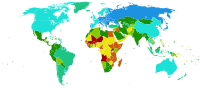
Photo from wikipedia
Abstract Population growth rate estimators have recently emerged in demographic temporal frequency analysis (dTFA) as further tools to monitor pre-census population dynamics. The information that such estimators supply affords considerable… Click to show full abstract
Abstract Population growth rate estimators have recently emerged in demographic temporal frequency analysis (dTFA) as further tools to monitor pre-census population dynamics. The information that such estimators supply affords considerable heuristic potential for population-ecological research both because they implicate the environmental, behavioral, and physiological mechanisms that condition population growth, and because they impose much-needed empirical constraints on our efforts to build theory addressing long-run human population dynamics. However, the earnestness with which these estimators have been applied warrants caution. First, several nonidentical measures of population growth are current in both formal demography and dTFA, creating an opportunity for their equivocation. Second, our ability to insightfully interrogate growth estimates for population-ecological information has been checked by a tendency to interpret them in the framework of off-the-shelf parametric growth models ill-suited to long-run population dynamics. This paper evaluates the biodemographic merit of three estimators recently applied in dTFA. It also advocates a transition away from parametric and toward dynamic growth models and introduces an inductive, regression-based approach to the latter. A Monte Carlo simulation study indicates that this inductive approach can successfully recapture information about environmental influences on population growth from archaeological summed probability distributions, less so from kernel density estimates.
Journal Title: Journal of Archaeological Science
Year Published: 2017
Link to full text (if available)
Share on Social Media: Sign Up to like & get
recommendations!